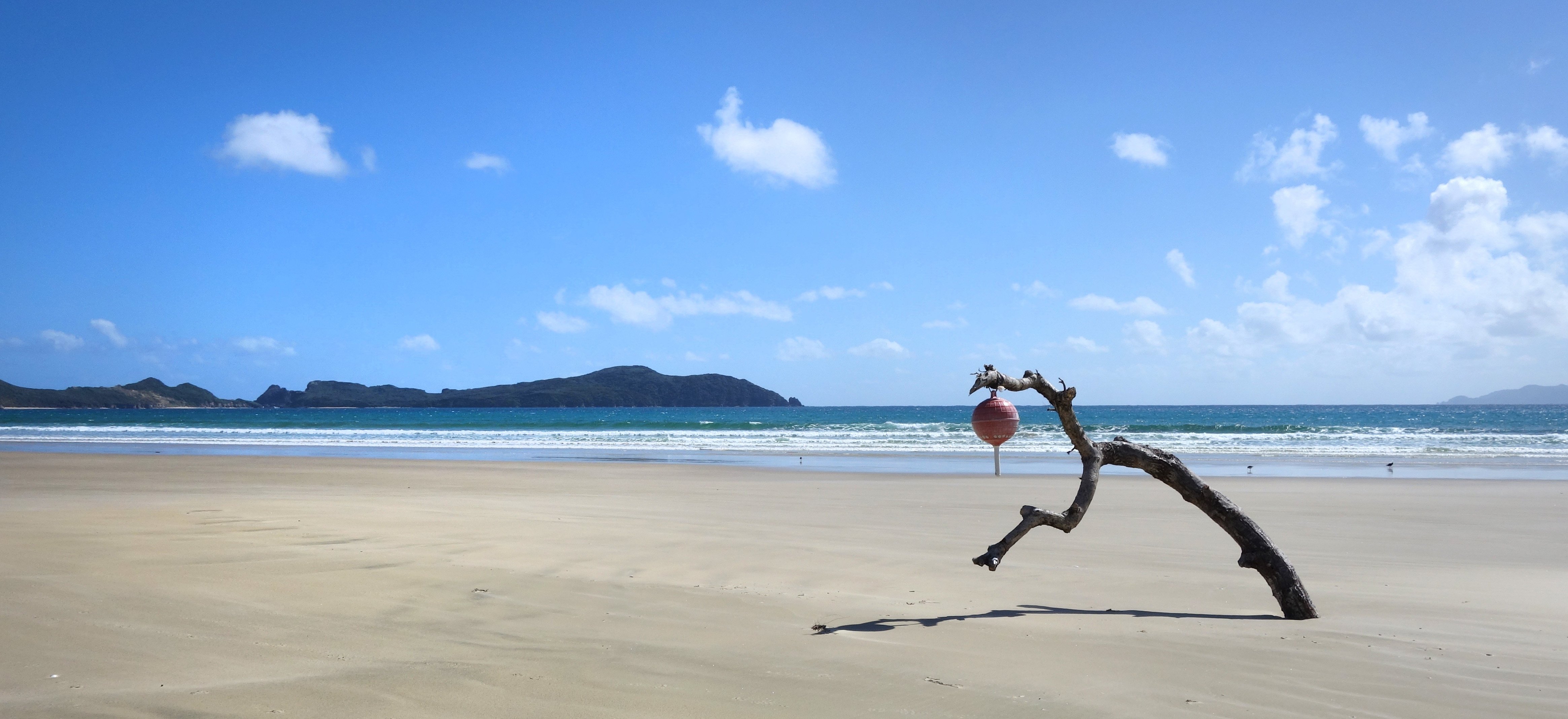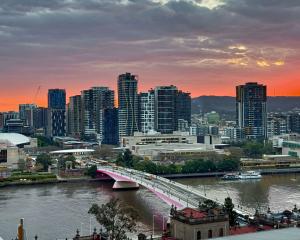
There is more to Stewart Island than meets the eye, writes Lisa Scott.
Much to my embarrassment, I had never been to Stewart Island: the Maori name of which, Rakiura, means "the great and deep blushing of Te Rakitamau", (an early Maori chief) seen today in glowing sunrises, sunsets, and the Aurora Australis.

"Me neither," said almost everyone before I left to visit this embarrassment of riches.
The chain links by sculptor Russell Beck running into the sea at Stirling Point and out again at Lee Bay, are a symbolic tethering to an island many have only seen from afar.
Sam, of Stewart Island Flights, takes off from Invercargill Airport, flying over Oreti Beach where a shark cruises behind the white water, grey against the blue. The Britten Norman Islander’s controls remind me of a drug smuggler’s plane crashed in the jungle in the movies, rows of little dials and switches. Tarns seen from above are sky mirrors. A deer leaps up from the tree cover.
We land on sand at low tide at the end of fish hook-shaped Mason Bay, 19km long and raked back into a receding hairline of massive sand dunes by the westerly. Waiting on the beach: a hunter with one arm in a sling. Sam hefts a bleeding bag into the hold (Stewart Island Flights pilots are aviation Everymen: surfers, tour guides, luggage handlers, refuellers, downhill bikers and ambulance drivers) before taking off overhead like rescue in reverse. When the engine noise fades to nothing I start to feel that something is wrong. Something’s missing. What have I forgotten? Please god, don’t let it be the repellent! It takes a while to work out that its’ the ceaseless "be careful" and "watch out" and "mind how you go" of the mainland. Marooned the wild, I’ve been left to my own devices, left to rely on my own common sense. It’s a terrifying idea.
The old homestead at Kilbride is a monument to failed experiments in farming, the last sheep left in ’87, had enough dragging his sand-heavy wool around. Farming here seems an insane decision, as cock-eyed as the remaining fence posts, dragged under by shifting sands. Lonely, hard, endless mutton. Mutton stew, mutton soup, mutton salad. You’d be tempted to eat a few kiwi, just to stop the monotony. There are 20,000 kiwi on Stewart Island, the largest population in the world; no stoats no weasels, they grow fat and ungainly, tripping over their own feet while rooting about in the undergrowth, landing on their barge arses. Poking knitting needle beaks into the ground the local Maori called them "weka with a walking stick": Tokoeka. Not bothered by humans out at night to watch them under red lights, you could pluck them for a cloak and I don’t think they notice for ages.

The Bluff chief moved his people to the promontory above "the Gutter" (an isthmus where ambergris sometimes washes up) to protect them from attack and remains are sometimes discovered here and reinterred with love. Not so lucky, 107 pilot whales that stranded here in 2011, spine and rib bones chalky and porous, invite the blessing of our fingers on the long walk to Mason Bay hut past the shells of paddle crabs, red kelp in matted dreadlocks. We’d filled our water bottles from the homestead rain barrel tap and, taking a swig, something prickles the inside of my mouth. A leaf? I spit it out and it unfurls into a huge hairy spider. Screaming my head off I jigger down the beach, where I spot the first buoy, hanging from a piece of driftwood like Christmas. A little further along, another tied to a post as track marker. At first whimsical, in the four-hour walk we see more and more flotsam and jetsam, more and more debris, including the ubiquitous blue packing tie, here so long it’s coming out of the sand dunes, like nasty fossils. Fish bins, nets, polystyrene balls — I’m overwhelmed by plastic by the time we get to the clearing where Mason Bay hut sits, lovely and new, next to a stream.
We make pasta (because we flew in we decided to be dumb and bring 2kg of pasta and sauce which we then had to carry from one end of the beach to the other) while one of those women, officious even among strangers, hands out census forms and then proceeds to talk non-stop in a drilling voice on the subject of absolutely nothing (about which she knows a great deal) until she drives everyone to an early night. We leave after breakfast, chased away by the woman, who probably has a hearing problem, bless her. Her male companion asks for Blu Tack but we haven’t bought any with us.
The track to Freshwater Hut is boardwalk through boggy wetlands, reeds either side. Sucking mud up to your knees, a road was once put in here, manuka logs piled up and topped with sand, locals paid to maintain it. The water took it back. A motorcycle with a wooden box once attached for deliveries lies in pieces on the side of the track like a skeleton scattered by dogs. It rains briefly and then the sun comes out and dries up all the rain and I think of poor Incy Wincy from yesterday.

Crossing a swing bridge above the tannin-stained river that twangs and sways, we drop off our packs and set off up Rocky Mountain, steep with slippery toe-catching roots, scolded by a pair of kaka, for stunning views of the island. I think of all the wildly different environments we have moved through: sweeping beaches, headland, sandhills, swamp, ponga-fronded kauri rata, beech and podocarp forest, and now alpine tundra. The down is hell on the knees, company at Freshwater that night a foursome of American youths, who give me hope for that country’s future. If they went home, that is, and they have no intention of doing so. A wonderful democracy establishes: German, Spanish, American, Australian and New Zealander. If we could rule the world from here it would be a better place.
The water taxi comes up the tea-coloured river at high tide to Freshwater Landing (the shallow delta can only be negotiated then), in the orange light of misty morning like the Heart of Darkness without the lunacy. Wind-kissed we soon arrive at the dock of Oban, postcard pretty; the kind of place that everyone says, upon arriving, "Oh, I could easily live here," and locals say, out of the side of their mouths, "we should cap the population at 300". Because that’s what it is.
"I must go over to New Zealand someday," says a wry plaque set into the path leading to the chain linking the mainland, Maui’s canoe, to its anchor stone. The top isn’t painted, I guess someone couldn’t be bothered, and it was shot at not long after the sculpture was installed. I’d made the leap linking the two parts of my country: tame and wild and was loath to leave the latter. Penguin tracks criss-crossed kiwi ones on the sand as we walked to the South Seas Hotel for a beer and hot chips before boarding.
"Hang on, we’re missing one," said the pilot, sending the van back to the pub.
"Did you bring us a pint?" asked a passenger.
"I was working," said Almost Missed Flight indignantly, before falling asleep. Taking off, and all too soon over the industrial backside of Invercargill, I immediately start making plans to go back to Stewart Island and live there forever. Don’t tell the locals.
Lisa Scott visited Stewart Island courtesy of Stewart Island Flights and Venture Southland.













